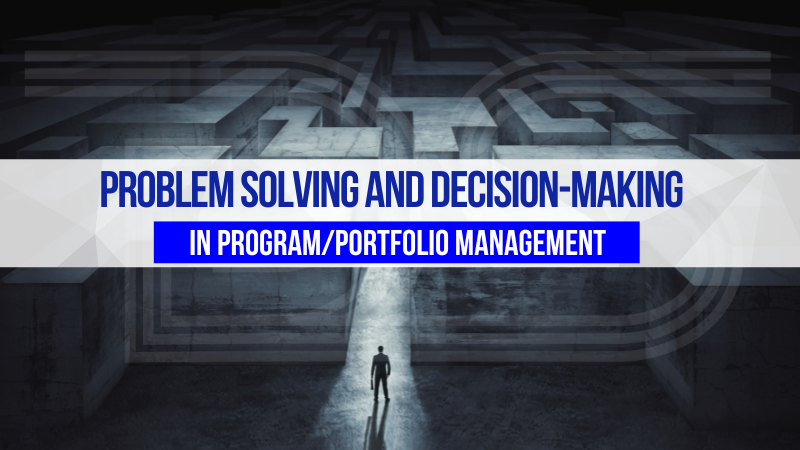
Problem Solving and Decision-Making in Program/Portfolio Management
Program/portfolio managers must make significant and minor decisions in the ever-changing project management environment. In many instances, their judgments and actions due to their more critical decisions may significantly influence their well-being and the prospects of clients and team members. Moreover, such decisions can impact the very nature of our jobs and even the lives of others who rely on them.
As equal to decision-making, problem-solving skills are essential in project management. Problem-solving is a project management skill that combines creative thinking and strong analytical abilities to assist effective problem solutions. This skill allows the project leader to look at challenges from a different angle and assist in designing and implementing successful solutions for making great decisions.
It’s easy to understand how, in problem-solving, recognizing simple solutions to complicated challenges might benefit the project and the company. Still, not all competent Project Leaders are capable of doing so. To be an effective problem solver and decision maker, the program/portfolio manager must possess specific skills and techniques to manage the project successfully.
Understanding the Decision Making Process in Project Management
All managers and other interested stakeholders must have a thorough grasp of decision-making in project management. The project will only then be able to progress toward the final delivery phase while maintaining the established timelines. The project runs a significant risk of stagnating or moving extremely slowly in this absence.
However, many businesses need help on several fronts because they need to recognize the value of decision-making in their management teams.
A McKinsey survey found that roughly 80% of professionals thought their firms’ decision-making processes could have been more efficient. Furthermore, the firms that demonstrated superior decision-making skills and topped the survey had better financial and performance outcomes.
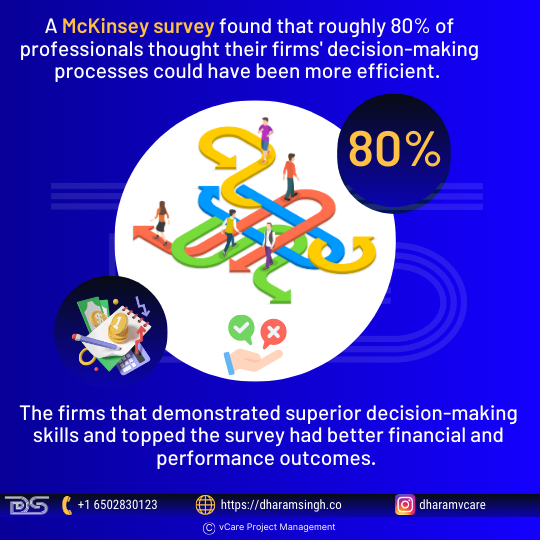
Why Efficient Decision-Making Matters for Firms
Decision-Making Types in Program/Portfolio Management
Decisions need to be made regularly in project management. Most are minor, but others are significant and will determine whether the project succeeds or fails. The same applies to program/portfolio management. Final choices can be reached using either an intuitive or logical method or a combination of the two. More intricate conclusions typically need a more formal, systematic approach incorporating intuition and reasoning. Not all decisions are the same. Management must make many decisions during a project, and each decision-maker is unique. The most common ones are listed below:
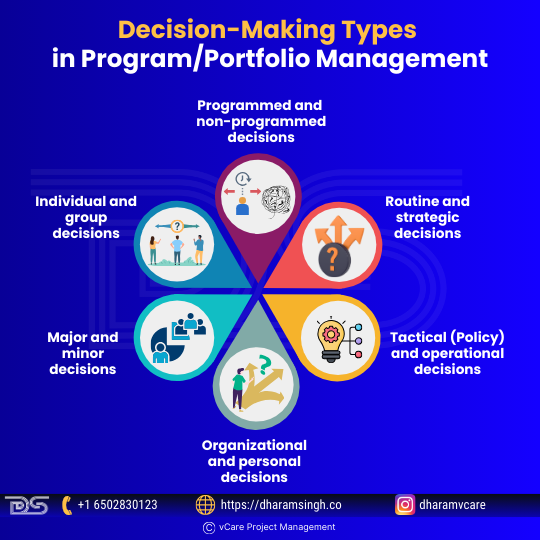
Decision-Making Types in Program/Portfolio Management
- Programmed and non-programmed decisions
Programmed decisions are concerned with problems of a repetitive nature or routine type matters. For example, decisions of this type may pertain to purchasing raw materials, granting leave, and supplying goods to the employee. Non-programmed decisions are made in challenging situations with no clear solution. These decisions need more attention, resources, and time and are usually made at a higher level.
- Routine and strategic decisions
Routine decisions affect the overall operation of a project and can be made rapidly. Within the broad policy framework of the project manager or the organization, ample powers are granted to lower ranks to make these decisions. However, strategic decisions are essential and affect objectives, organizational goals, and other important policy matters. These decisions usually involve a program’s orientation or huge investments in portfolios, are non-repetitive, and are taken after careful analysis and evaluation of alternatives.
- Tactical (Policy) and operational decisions
Portfolio managers make policy decisions that have a long-term impact on the functioning of the concern. For example, decisions regarding how many projects can be run each time according to the budget are policy decisions. On the other hand, operational decisions relate to the day-to-day functioning or operations of the business. Middle—and lower-level managers make these decisions. For example, decisions concerning the payment of bonuses to employees are operational rather than policy decisions.
- Organizational and personal decisions
When an individual decides their responsibilities and tasks within the project, it is an organizational decision. But, if the individual decides on personal matters, it’s a personal decision. The authority to make organizational decisions may be delegated, whereas personal decisions cannot.
- Major and minor decisions
A decision related to increasing the number of resources by 50% is a major decision. A minor decision, for example, is that the superintendent can purchase office stationery.
- Individual and group decisions
When an individual decides within an organization, it is known as an individual decision. However, when it comes to more crucial decisions, more stakeholders need to engage and assist in making a decision. Therefore, it is interesting to investigate in which cases a project manager should involve other project members.
Decision-making Tools and Techniques
Project managers frequently employ additional measures to support the validity of their decisions. While the fundamental concepts remain the same, hundreds of distinct ways and tools are available. A mixture of these strategies can also be employed to make better decisions. Project managers would benefit from knowing which are appropriate and applicable in any given situation.
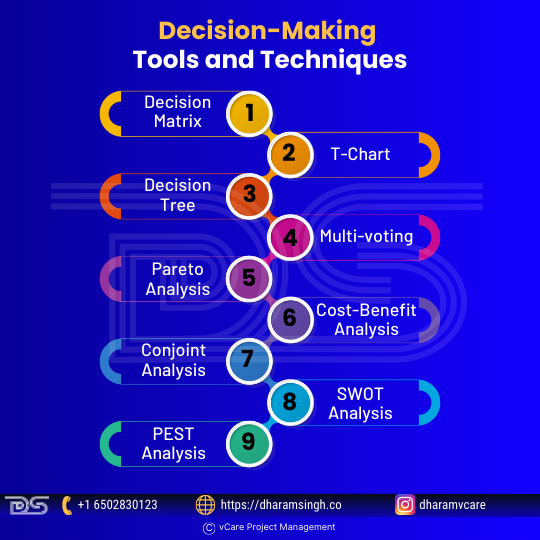
Decision-making Tools and Techniques
- Decision Matrix: A decision matrix examines all of a choice’s possibilities. When utilizing the matrix, create a table with all the alternatives in the first column and the criteria influencing the decision in the first row. Users then rate each choice and choose which criteria are most important. After that, a final score is calculated to determine the best option.
- T-Chart: This chart analyzes the benefits and drawbacks of the alternatives. It guarantees that all of the advantages and downsides are considered when deciding.
- Decision Tree: This is a graph or model for assessing each option and its outcomes. This approach is also used for statistical analysis.
- Multi-Voting: This is utilized when multiple people decide. It helps narrow down many possibilities to a smaller one that leads to the final decision.
- Pareto Analysis: This technique is used when making many decisions. This analysis aids in selecting which decisions should be made first by calculating which ones will have the largest overall impact.
- Cost-Benefit Analysis: This strategy assesses the financial implications of each feasible alternative to arrive at the most economical conclusion.
- Conjoint Analysis: Business leaders use this strategy to assess consumer preferences when making decisions.
- SWOT Analysis: This planning tool examines SWOT (strengths, weaknesses, opportunities, and threats).
- PEST Analysis: PEST, which stands for political, economic, social, and technical aspects, can help decision-making and timing by analyzing external factors. This method takes current trends into account to forecast future ones.
Importance of Decision-Making
Decision-making is an acquired skill rather than an inherent one that is in high demand in the workplace. However, employers consider it an appealing trait as it signifies a good leader. Therefore, demonstrating your decision-making abilities can help you advance your career and accomplish company objectives and goals.
Here are some of the benefits of making correct decisions:
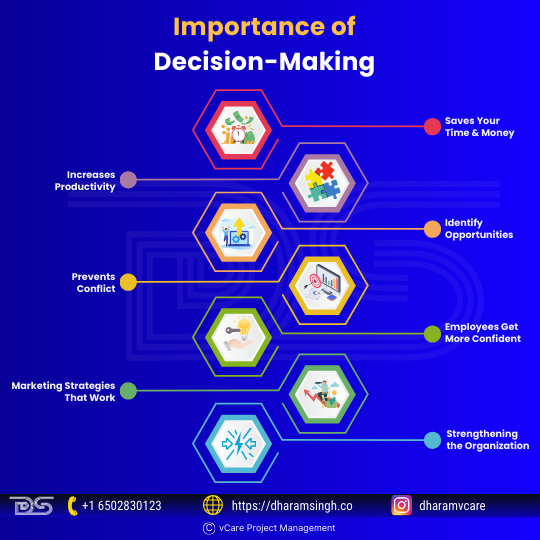
Importance of Decision-Making
- Saves Your Time & Money
Ineffective decision-making requires some time and depletes the motivation of those engaged. The less time you waste making rapid decisions, the better. When it comes to running a business, time is money. Wasting time is the same as wasting money.
- Increases Productivity
When management excels at making decisions and developing good ones, it will boost the workforce’s productivity. Employees will be motivated, for one thing, since they know where the organization is heading. They will strive with the conviction that their efforts will succeed. All time is preserved because the management team is convinced that their activities will correctly guide their organization.
- Identify Opportunities
The key is to recognize the opportunities in front of you and be able to act on them. If there is a great demand for a product in the market and your firm can offer it, wrong or delayed decision-making may prevent you from focusing on it. On the other hand, poor decision-making can make opportunities appear non-existent.
- Prevents Conflict
A manager’s failure to make strong, fair decisions can lead to workplace conflict. Conflicts in the lower tiers also occur when management needs to be more assertive and leave more decisions to their employees. Good decision-making skills can prevent employee conflicts regarding which idea is better for their team or how to maintain a project.
- Employees Get More Confident
Project leaders can become role models and show their employees they are good decision-makers. As a result, employees will trust and follow them confidently, even in the darkest times. When their staff feels that they trust their decisions at every moment, they are more likely to develop new innovative ideas that could benefit the overall business.
- Marketing Strategies That Work
Several critical considerations must be made when implementing successful marketing campaigns. Decision-making is the most important factor in developing strategies and making them stand out. No matter how good the products or services are, the firm will only reach its full potential if it can effectively advertise its brand.
- Strengthening the Organization
Everyone has an equal right to participate in the management of the organization. This aspect fosters a spirit of teamwork and solidarity among those who work there, improving the organization’s overall productivity and strengthening its general structure. Decision-making allows individuals working in an organization to convey their ideas equally.
Decision-making and its impact on problem-solving
The importance of decision-making in problem-solving is apparent and an essential component of efficient project management. A project manager’s capacity to make sound decisions and solve problems correctly is critical since it influences organizational functioning. Problem-solving and decision-making are sometimes inextricably linked; one must better decide to solve a problem.
Problem-solving is a key skill that makes one an excellent project leader. Problems are unavoidable when it comes to project management. Because we all encounter similar scenarios in our everyday lives, what makes a difference is knowledge and how well we use it to tackle a present or looming problem. In project management, problem-solving and resolution are strategic processes. As a result, one won’t be able to master that talent overnight. Instead, it requires incremental learning, using a framework, and preserving some critical factors.
Why are problem-solving skills necessary?
When potential employers discuss problem-solving, they aim to assess how team members use this talent to assist decision-making in the company’s day-to-day operations. Here are four reasons why problem-solving skills are vital in the workplace:
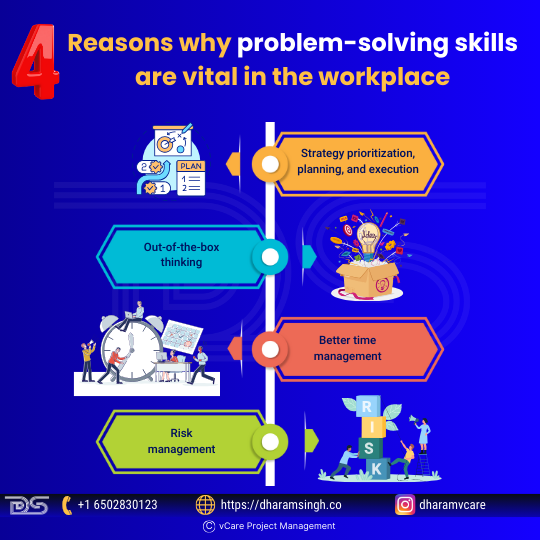
Why are problem-solving skills necessary?
- Strategy prioritization, planning, and execution
Efficient problem solvers may thoroughly examine consumer requirements and devise a strategy that allows them to give outstanding service to their intended audience. Their expertise is in simplifying procedures by eliminating bottlenecks.
- Out-of-the-box thinking
Problem-solving and creative thinking are inextricably linked. Finding a dynamic and innovative solution to a problem is not a matter of finding an instant solution but a dynamic and innovative solution. This mindset assists the company in staying ahead of the curve and gradually improving the workforce’s competence.
- Better time management
When an issue emerges, it must be resolved as soon as possible. Employees with strong problem-solving abilities are laser-focused on what is critical to the organization, can roll with the punches, and can meet tight deadlines.
- Risk management
Effective planning is a necessary problem-solving ability. Problem solvers may respond rapidly to short-term circumstances while keeping an eye on the future. Their positive approach toward learning agility enables them to foresee future challenges based on prior experiences, industry trends and patterns, and current events.
Problem-solving Techniques
Complex problems might be challenging to solve, yet difficulties can be addressed when the correct tools are used. Aside from sophisticated management tools, here are some tools and technologies that can help with problem-solving approaches in your everyday work.
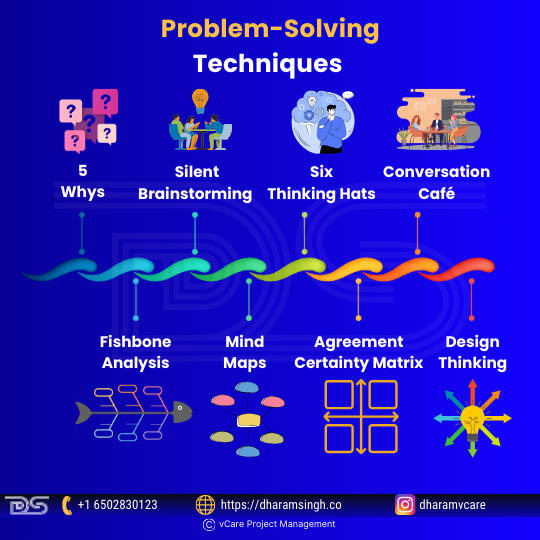
Problem-solving Techniques
- 5 Whys – Understanding the problem better is a wonderful strategy to find the core cause.
- Fishbone analysis – used to visualize the fundamental causes of an issue. Simple to use in conjunction with ‘5 Whys’ or ‘Mind mapping’ to brainstorm and discover the source and impact of any problem.
- Silent brainstorming – allows everyone to engage in idea generation since the loudest and quietest persons will contribute equally. This technique is useful because everyone’s point of view is equally valid.
- Mind maps – are organized visual representations that allow one to exchange ideas, thoughts, and solutions like your brain does. You immediately describe the issues, discuss new ideas, and eventually reach a team agreement that can lead to a successful solution.
- Six thinking hats – This technique allows your team to approach challenges from several perspectives, concentrating on facts, creative ideas, or why some solutions may not work.
- Agreement certainty matrix—another fantastic visual tool for brainstorming issues and challenges. It categorizes them as simple, complicated, complex, or chaotic domains to help teams agree on what technique should be utilized to handle the real problems impacting them.
- Conversation café: This allows the team to have constructive conversations with less argument and more active listening. The problem is addressed in rounds of dialogues until a consensus is reached on the best problem-solving technique.
- Design thinking: When you’re stuck for new ideas, the 5-step approach will help you empathize with the problem, then define and create new concepts before prototyping and testing them.
What are the critical problem-solving skills?
Problem-solving skills enable firms to seek and recruit intellectually equipped personnel who can handle anything their professions throw at them. Problem solvers can watch, assess, and act quickly when the situation demands it- without negatively impacting the business. The following are the top problem-solving skills in the workplace:
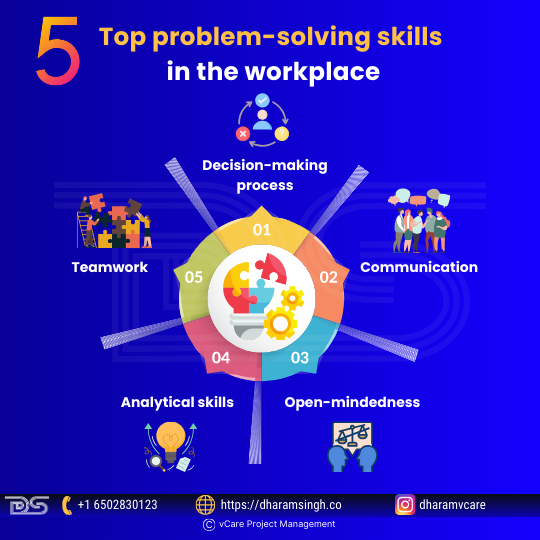
Top problem-solving skills in the workplace
- Decision-making process
Problem-solving requires the ability to make decisions. One can only solve it if one fully comprehends the issue and decides to take action. Decision-making abilities enable experts to rapidly choose between two or more solutions after weighing the benefits and drawbacks of each.
- Communication
Communicating the problem and offering remedies vocally and in writing is an art in and of itself. However, proper communication ensures that solutions are implemented successfully and that all parties engaged in the disagreement agree.
- Open-mindedness
Open-mindedness is the readiness to explore new ideas and look at things from a new viewpoint. When faced with an issue, consider all of its viable solutions. Being curious and observant allows one to be a better problem solver.
- Analytical skills
Almost all problem-solving scenarios need analysis, such as predicting, critical thinking, or troubleshooting. Analytical skills allow one to comprehend the situation better and generate effective answers based on facts and data.
- Teamwork
Collaboration is essential for keeping communication lines open, problems cooperatively addressed, and the team aims before personal ambitions.
Team dynamics are important in problem-solving because they allow one to work together with others toward a common objective.
Final Thoughts
The majority of problems start modestly. Creative program/portfolio managers are responsible for finding solutions as quickly as feasible. The longer they wait, the worse the situation will get.
They may break out of that cycle with a strategic problem-solving framework and quickly find solutions to difficulties using ideal project management automation technology. However, making decisions is crucial to solving problems. Making decisions may be a painstaking process in project management. However, the decisions made inside the team significantly impact a project’s success.
In the future of employment, net new jobs will be created at the same pace as dying jobs. Human talents such as creativity, decision-making, problem-solving, invention, and critical thinking will become more in demand as technology replaces employment requiring repetitive and boring operations. Organizations that get a head start on measuring these human talents in their workforce now and provide strategic learning and development opportunities to upskill them will gain a competitive edge as we enter the Fourth Industrial Revolution.
Jobs we will never see coming will rise rapidly in the future of work (or what many call “The Fourth Industrial Revolution”). The “proper” professional path or education of an ideal individual for these professions will not be clear. We will need to quantify people’s human talents to position them in positions; not only are these skills transferable across unconventional career choices, but these distinctive human skills will also be protected against automation.
Thus, advanced certifications like PMP®, Agile, PgMP®, and PfMP® certifications can help one develop project management skills, be a good problem solver, be a more competitive candidate for positions, and be a successful project leader. In today’s competitive business world, one must be skilled and experienced to succeed and grow one’s career.



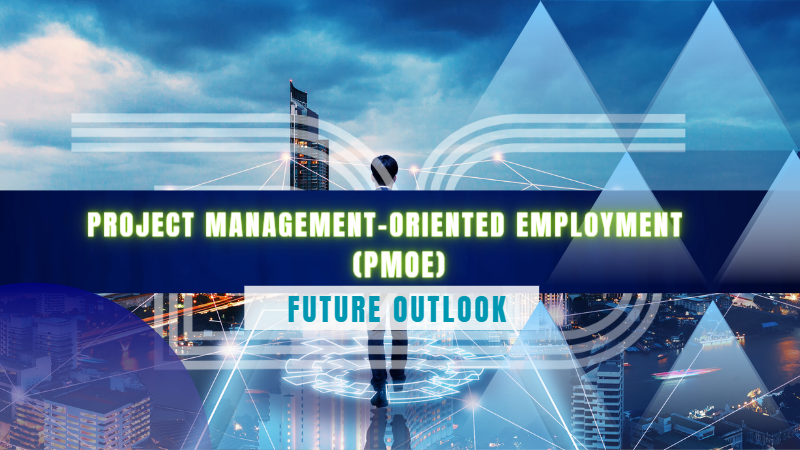






Recent Comments